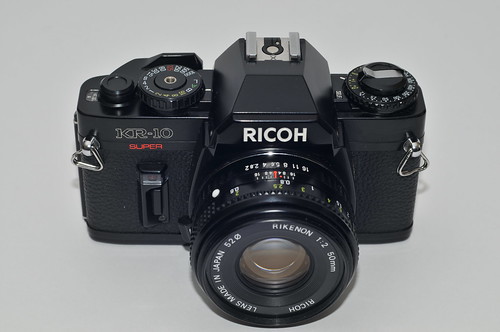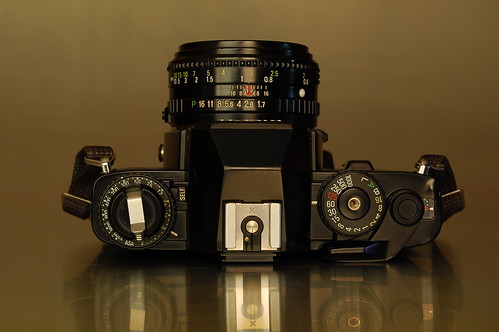Difference between revisions of "Ricoh KR-10 Super"
m (typos) |
(Delete add'l Sears text I overlooked (now in separate article); expand some feature description) |
||
| Line 10: | Line 10: | ||
The '''KR-10 Super''' was introduced by [[Ricoh]] in 1983, as a significant revision to the previous [[Ricoh KR-10 | KR-10]] (without suffix). The changes include expanding the range of slow shutter speeds from 4 to 16 seconds; moving the shutter release to be concentric with the shutter-speed dial; and changing to an electronic self-timer with a front-facing indicator LED. (It shares some of this DNA with the more stripped-down [[Ricoh XR 500 Auto |XR 500 Auto]].) | The '''KR-10 Super''' was introduced by [[Ricoh]] in 1983, as a significant revision to the previous [[Ricoh KR-10 | KR-10]] (without suffix). The changes include expanding the range of slow shutter speeds from 4 to 16 seconds; moving the shutter release to be concentric with the shutter-speed dial; and changing to an electronic self-timer with a front-facing indicator LED. (It shares some of this DNA with the more stripped-down [[Ricoh XR 500 Auto |XR 500 Auto]].) | ||
| − | It takes 24x36mm images on 135 film and is fully reliant on the batteries to operate. | + | It takes 24x36mm images on 135 film and is fully reliant on the batteries to operate. The "A" setting on the shutter dial switches to aperture-priority autoexposure (where the camera automatically adjusts its shutter speed to suit the aperture and light level). Pressing a button on the front of the camera previews the selected speed alongside the viewfinder image. A wide variety of [[K mount lenses]] from different brands will achieve this correctly, in contrast to Ricoh's "Program" exposure models which required Ricoh-specific lenses. |
The [[Sears KSX Super]] is functionally the same camera although with a slightly different grip. | The [[Sears KSX Super]] is functionally the same camera although with a slightly different grip. | ||
Revision as of 15:17, 3 May 2021

|
| image by David Donnadieu (Image rights) |
The KR-10 Super was introduced by Ricoh in 1983, as a significant revision to the previous KR-10 (without suffix). The changes include expanding the range of slow shutter speeds from 4 to 16 seconds; moving the shutter release to be concentric with the shutter-speed dial; and changing to an electronic self-timer with a front-facing indicator LED. (It shares some of this DNA with the more stripped-down XR 500 Auto.)
It takes 24x36mm images on 135 film and is fully reliant on the batteries to operate. The "A" setting on the shutter dial switches to aperture-priority autoexposure (where the camera automatically adjusts its shutter speed to suit the aperture and light level). Pressing a button on the front of the camera previews the selected speed alongside the viewfinder image. A wide variety of K mount lenses from different brands will achieve this correctly, in contrast to Ricoh's "Program" exposure models which required Ricoh-specific lenses.
The Sears KSX Super is functionally the same camera although with a slightly different grip.
Specifications
- Film Format and Frame Size: 35mm film, 24x36mm.
- Lens Mount: K Mount
- Exposure meter: TTL full open metering for center-weighted average light reading coupled automatically to f-stop.
- Focusing: Split-image spot in microprism band
- Film Speed: ASA 12-3200
- Shutter: Electronically controlled. 16sec - 1/1000sec +B.
- Viewfinder: Field of view covers 93%. 0,88X magnification.
- Flash terminal: X synchro contact
- Batteries: Two LR-44 Alkaline batteries or two SR-44 Silver Oxide batteries.
- Liquid Cristal Display in the viewfinder.
- Dimensions: 136 x 86 x 51mm
- Weight: Approx.460g

|
| image by Raúl Sá Dantas (Image rights) |
Links
- Ricoh KR-10 Super instruction manual from Mike Butkus' OrphanCameras.com
In Japanese